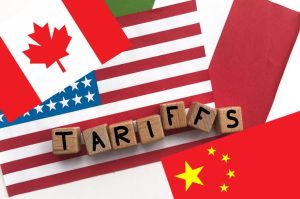The Indian stock market, including the BSE Sensex and NSE Nifty50, experienced a significant decline on April 4, 2025, due to several key factors. Here are four reasons behind the market crash:
-
 Trade War Concerns Following Trump’s Tariff Announcement: US President Donald Trump’s decision to impose a universal 10% baseline tariff on U.S. imports, with higher tariffs for countries like India (26%), China (34%), and others, reignited global trade tensions. This move sparked fears of a trade war and heightened uncertainty in global markets.
Trade War Concerns Following Trump’s Tariff Announcement: US President Donald Trump’s decision to impose a universal 10% baseline tariff on U.S. imports, with higher tariffs for countries like India (26%), China (34%), and others, reignited global trade tensions. This move sparked fears of a trade war and heightened uncertainty in global markets. -
Global Recession Fears: The announcement of new tariffs exacerbated existing concerns about a potential recession in the U.S. and globally. These fears led to a broad-based selloff in markets worldwide, affecting investor sentiment and contributing to the sharp decline in Indian indices.
-
Impact on Indian Pharmaceutical Sector: Although initially exempted, there were reports that Trump might impose tariffs on the pharmaceutical sector, which is a significant export-oriented industry for India. This uncertainty further pressured the market, particularly pharma stocks, despite some initial gains due to exemptions.
-
Heavyweight Stocks Dragging Indices: The decline in shares of heavyweight companies, such as Reliance Industries, also contributed to the market downturn. RIL’s stock fell over 4% due to declining oil prices and global demand concerns, exerting significant pressure on the Sensex
Global Market Turmoil: How Trump’s Tariffs Sparked a Sharp Decline in Indian Stock Markets
On April 4, 2025, the Indian stock market experienced a significant downturn, with the BSE Sensex plummeting by over 800 points and the NSE Nifty50 dropping below 23,000. This sharp decline was part of a broader global market selloff triggered by U.S. President Donald Trump’s announcement of sweeping tariffs on imports. The move reignited fears of a trade war, impacting markets worldwide.
Trump’s Tariff Announcement
President Trump introduced a universal 10% baseline tariff on all U.S. imports, with higher tariffs imposed on countries with large trade surpluses. India, for instance, faces a 26% tariff, while China is hit with a 34% tariff. Other countries like the EU (20%), South Korea (25%), Vietnam (46%), Taiwan (32%), and Japan (24%) also face increased tariffs. This move has heightened global trade tensions and sparked concerns about retaliatory measures from affected nations.
Impact on Global Markets
The global market reaction was swift and severe. Wall Street experienced its worst day since 2020, with the Dow Jones Industrial Average dropping 3.98%, the S&P 500 falling 4.84%, and the Nasdaq plummeting 5.97%. Asian markets followed suit, with Japan’s Nikkei 225 losing 2.6%, Hong Kong’s Hang Seng down 1.52%, and Australia’s S&P/ASX 200 dropping 1.9%.
Indian Stock Market Decline
In India, the Sensex fell by as much as 860 points, while the Nifty50 dipped by nearly 340 points. The total market value of BSE-listed companies decreased by approximately Rs 9.5 lakh crore, reflecting the broad-based selling across sectors including metals, pharmaceuticals, and IT. Stocks like Tata Motors, Tata Steel, and Reliance Industries were among the major losers, while HDFC Bank and Bajaj Finance managed to gain


Sectoral Impact
-
Pharmaceutical Sector: The potential for tariffs targeting the pharma sector added to investor concerns, leading to a decline in pharma stocks.
-
IT Sector: The Nifty IT index dropped by 3%, with stocks like Persistent, Wipro, and Tech Mahindra experiencing significant declines due to weaker earnings expectations for Q4FY25.
-
Metals and Autos: These sectors also faced significant losses, contributing to the overall market downturn.
Economic Implications
The imposition of tariffs by the U.S. has raised fears of a global trade contraction and declining economic growth. This uncertainty is expected to persist, affecting investor sentiment and market stability. As global markets continue to react to these developments, the Indian stock market is likely to remain volatile in the coming days.
Long-Term Economic Implications of Sustained U.S. Tariffs
The continuation of President Trump’s 2025 tariffs—including a universal 10% baseline tariff and higher country-specific rates—could reshape the U.S. economy and global trade dynamics. Here’s a detailed analysis of the potential long-term consequences:
1. Permanent Reduction in U.S. GDP
-
Real GDP Contraction: Sustained tariffs could permanently reduce U.S. real GDP by 0.6% to 2%, equivalent to $100–$180 billion annually in lost economic output. This stems from disrupted global supply chains, reduced export competitiveness, and inefficient reallocation of resources toward lower-value domestic production.
-
Growth Slowdown: The tariffs are projected to lower U.S. real GDP growth by -0.9 percentage points in 2025, with lingering effects persisting for decades.
2. Inflation and Consumer Burden
-
Price Surge: Tariffs could raise the U.S. price level by 2.3% in the short term, costing households $3,800 annually on average. Lower-income households would bear a disproportionate burden, losing $1,700 per year.
-
Sector-Specific Inflation: Apparel and textiles could see 17% price hikes, while autos and electronics face significant cost increases due to disrupted imports.
3. Global Trade Contraction and Retaliation Risks
-
Trade War Escalation: Retaliatory tariffs from China, the EU, India, and others could shrink global trade volumes by 1% in 2025, exacerbating economic stagnation.
-
Export Collapse: U.S. exports are projected to decline by 18.1% long-term, particularly in agriculture and manufacturing, as foreign markets impose counter-tariffs.
- Where We Stand: The Fiscal, Economic, and Distributional Effects of All U.S. Tariffs Enacted in 2025 Through April 2 | The Budget Lab at Yale
4. Sectoral Vulnerabilities
-
Manufacturing and Autos: Highly integrated North American supply chains face severe disruption, with auto production costs rising due to tariffs on intermediate goods.
-
Agriculture: Retaliatory measures from China and Canada threaten $100 billion in U.S. agricultural imports, destabilizing rural economies.
5. Long-Term Structural Shifts
-
Investment Diversion: Resources could shift toward lower-productivity industries, reducing overall economic efficiency and innovation.
-
Dollar Volatility: A weaker dollar might offset some tariff impacts but could destabilize financial markets and increase import costs.
- Trump Tariffs: Prices & Long-Term Economic Effects
6. Global Recession Risks
The tariffs amplify existing pressures on a post-pandemic global economy, raising the likelihood of a worldwide recession. J.P. Morgan estimates a “materially higher risk” of such an outcome if trade tensions escalate further
Negative Impacts
-
Gems and Jewellery Sector: The imposition of a 27% tariff on gems and jewellery exports to the U.S. is expected to significantly reduce demand, potentially leading to job losses in this industry. India’s gems and jewellery sector heavily relies on manual labor for diamond cutting, polishing, and making exquisite jewellery.
-
Electronics and Semiconductors: The tariffs could affect India’s electronics exports, particularly semiconductors, which are heavily reliant on U.S. demand. This could lead to reduced employment opportunities in these sectors.
-
Textiles and Apparel: While some analysts see opportunities for India in textiles due to higher tariffs on competitors like Vietnam and Bangladesh, the overall impact on jobs could be mixed. Higher costs due to tariffs might reduce competitiveness unless India can capitalize on these opportunities effectively.
-
IT Services: Although IT services are not directly impacted by tariffs, a weaker U.S. economy could slow demand for IT services, indirectly affecting employment in this sector.
Positive Opportunities
-
Manufacturing and Investment: The tariffs could encourage foreign investment in India as companies seek to avoid high tariffs in other countries. This could lead to job creation in sectors like textiles, electronics, and machinery if India can attract manufacturing operations relocating from countries like China and Vietnam.
-
Domestic Production: Higher tariffs on imports might encourage domestic production in certain sectors, potentially creating jobs in manufacturing and related industries.
Challenges and Uncertainty
-
Trade Negotiations: The ongoing trade tensions and negotiations could lead to uncertainty, affecting business decisions and investment plans. This uncertainty might delay investments and hiring in sectors heavily reliant on international trade.
-
Global Economic Slowdown: If the tariffs contribute to a global economic slowdown, India’s job market could face broader challenges due to reduced demand for exports and decreased foreign investmen
-
The imposition of tariffs by the Trump administration has far-reaching economic consequences, not just for the United States but for global trade and economic stability. While tariffs are often justified as tools to protect domestic industries and reduce trade deficits, their long-term effects reveal significant drawbacks that outweigh short-term gains.
Economic Costs in the U.S.
Trump’s tariffs have acted as a regressive tax on American businesses and consumers. By raising the cost of imported goods and raw materials, they have increased production costs for U.S. manufacturers and reduced the purchasing power of households, particularly those in lower-income brackets. Studies estimate that these measures have reduced U.S. GDP by up to 0.38% and eliminated hundreds of thousands of full-time equivalent jobs due to decreased competitiveness and higher operating costs.
Moreover, the tariffs have disrupted global supply chains, forcing companies to either absorb higher costs or pass them on to consumers. This has led to inflationary pressures in key sectors like steel, aluminum, electronics, and automobiles, further dampening economic growth.
READ MORE: Witness the Explosive Truth: Kesari Chapter 2 Brings Jallianwala Bagh to Life
-
Global Trade Disruptions
The tariffs have triggered retaliatory measures from key trading partners like China, Canada, and the European Union, creating a cycle of escalating trade barriers. These actions have reduced global trade volumes and increased uncertainty for businesses reliant on international markets. For example, China’s retaliatory tariffs on U.S. exports have not only hurt American farmers but also weakened global economic growth.
The broader shift toward protectionism undermines decades of progress made through trade liberalization, which had previously fostered economic growth, innovation, and consumer choice worldwide. Instead of addressing trade imbalances effectively, the tariffs have created inefficiencies by diverting resources from competitive industries to less efficient domestic sectors.
Impact on Strategic Goals
While the tariffs were initially framed as a means to enhance national security and protect American jobs, their outcomes suggest otherwise. Industries like steel and aluminum have seen temporary gains but at the expense of broader economic health. Additionally, the tariffs have not significantly improved the U.S.’s manufacturing base or reduced its reliance on imports.
In sectors like technology and semiconductors, where global collaboration is essential, the tariffs have stifled innovation by increasing costs and limiting access to critical components. This has weakened America’s competitive edge in high-tech industries.
Lessons for Policy
The long-term implications of Trump’s tariffs highlight the limitations of protectionist policies in a globally interconnected economy. While such measures may appeal politically by projecting strength in trade negotiations, they often result in unintended consequences that harm domestic economies more than they benefit them.
For sustainable economic growth, policymakers must focus on fostering open trade systems that encourage innovation and efficiency while addressing legitimate concerns like unfair trade practices through multilateral agreements rather than unilateral actions. Removing or reducing these tariffs could restore economic stability by boosting GDP growth, lowering prices for consumers, and improving global trade relations
- While Trump’s tariffs may have achieved short-term political objectives, their long-term economic impact underscores the need for balanced trade policies that prioritize both domestic prosperity and global cooperation.
-

